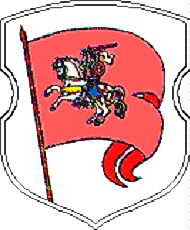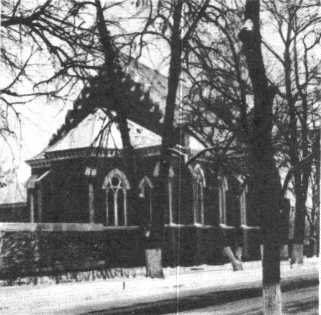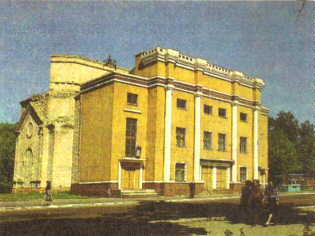
Coat of Arms of the town of Rechytsa
Interestingly this symbol of "Pahonia" or
"Chase" is very similar to the "Chase" symbol of the
Grand Duche of Lithuania - the former state symbol of the Republic of Belarus
and the current state symbol of modern Lithuania.

St.Trinity Roman Catholic Cathedral
The Cathedral was rebuilt in 1903. It is now a brick building
located in the center of the town biult in Neo-Gothic Style. The Cathedral was inactive
over USSR times. It was returned to service in 1980.

Rechytsa Regional Ethnographic Museum
It seems that Museum is housed in a re-constructed Rechytsa
Synagogue (rear part of the building). The museum was founded after WWII in 1952. It
has 15,000 items in exposition. The Museum has chapters of pre-Soviet history, Soviet
society history, Natural history. An important part of the Museum is a collection of
ancient "milagradskaia" culture artifacts, Belarusian icons dated XII-XVII cc.
Ethnografic collection houses objects of typical rural living of XIX-early XX cc. |
Rechytsa
Timeline
 1079 A.D.
According to one source an Orthodox Christian Church of Resurrection was built in Rechytsa
before even first mentioning of Rechytsa itself. 1079 A.D.
According to one source an Orthodox Christian Church of Resurrection was built in Rechytsa
before even first mentioning of Rechytsa itself.
 1190s.
Rechytsa is mentioned since the late XII century as a settlement in Valyn' Principality. 1190s.
Rechytsa is mentioned since the late XII century as a settlement in Valyn' Principality.
 1213. The
First Novgorod Chronicle mentions Rechytsa as a town of Chernihau
Principality. 1213. The
First Novgorod Chronicle mentions Rechytsa as a town of Chernihau
Principality.
 1315-1341. Became
a part of the Grand Duche of Lithuania during the ruling of Grand Duke Hedymin. 1315-1341. Became
a part of the Grand Duche of Lithuania during the ruling of Grand Duke Hedymin.
 1392 - 1430.
Rechytsa is owned by Vitaut. He had fortified the town and built Rechytsa castle. See
panoramic Rechytsa castle view from the old print above. 1392 - 1430.
Rechytsa is owned by Vitaut. He had fortified the town and built Rechytsa castle. See
panoramic Rechytsa castle view from the old print above.
 1511.
Zhyhimond the Old gives Rechytsa partial Magdebourg Rights. 1511.
Zhyhimond the Old gives Rechytsa partial Magdebourg Rights.
 1566. Rechytsa
Pavet (administrative district) is formed and Rechytsa becomes a district center of the
Grand Duche of Lithuania. The District and Civic Courts are opened in Rechytsa, which are
ruling on land and property issues. The local town issues are managed by Magistrate
(Majorate) - an elected body of selfruling, which gathers taxes and decides on the budget. 1566. Rechytsa
Pavet (administrative district) is formed and Rechytsa becomes a district center of the
Grand Duche of Lithuania. The District and Civic Courts are opened in Rechytsa, which are
ruling on land and property issues. The local town issues are managed by Magistrate
(Majorate) - an elected body of selfruling, which gathers taxes and decides on the budget.
 1603.
John Smith - future governor of an English colony in North America - has left this
record about Rechytsa: 1603.
John Smith - future governor of an English colony in North America - has left this
record about Rechytsa:
"...Rechytsa is situated on a steep right bank of Dnieper
river. A castle built in the beginning of XV century by Vitaut stands on the very bank.
This castle-fortress is covering an area of 2.5 acres. The castle has 5 polygon-shaped
towers covered with pyramid roofs. The castle is connected with town through a drawbridge.
Behind the castle there are market square, Magistrate buildings, houses of wealthy
townsmen, an inn. The market in Rechytsa at that time was very wealthy."
At that time rye and wheat grain, honey, wax, groceries were brought to the market from
the neighboring villages. Iimported goods like Turkish groceries were sailed in from the
South along the Dnieper river.
 1634.
Minsk Vaiavoda (Major) Aliaksandar Slushka, who had formerly served as Rechytsa Major, had
founded Dominican Monastery and St. Trinity Roman Catholic Church in Rechytsa. The
Monastery had several buildings, including a small library of 270 folios. This monastery
was stripped from state funding in 1832 and gradually abandoned. The wooden St. Trinity
Church perished in a fire of 1862. 1634.
Minsk Vaiavoda (Major) Aliaksandar Slushka, who had formerly served as Rechytsa Major, had
founded Dominican Monastery and St. Trinity Roman Catholic Church in Rechytsa. The
Monastery had several buildings, including a small library of 270 folios. This monastery
was stripped from state funding in 1832 and gradually abandoned. The wooden St. Trinity
Church perished in a fire of 1862.
 1648 - 1667. Ukrainian
Cossacks and Muscovy Wars have brought biggest destruction on Rechytsa throughout its
entire history. 1648 - 1667. Ukrainian
Cossacks and Muscovy Wars have brought biggest destruction on Rechytsa throughout its
entire history.
 1649. Rechytsa
Castle is destroyed by the Ukrainian Cossack Army of Zalatarenka. Later its ruins were
taken apart by locals for building materials. Only some ruins of the Castle have survived.
Cossaks and Muscovy Czar troops were fought off. But ever since Rechytsa begun to weaken. 1649. Rechytsa
Castle is destroyed by the Ukrainian Cossack Army of Zalatarenka. Later its ruins were
taken apart by locals for building materials. Only some ruins of the Castle have survived.
Cossaks and Muscovy Czar troops were fought off. But ever since Rechytsa begun to weaken.
 1829. Uladzimir
Sapovich - a known literary critic is born in Rechytsa. 1829. Uladzimir
Sapovich - a known literary critic is born in Rechytsa.
 1867. Belarusian
historian Mitrofan Dounar-Zapolski is born in Rechytsa. 1867. Belarusian
historian Mitrofan Dounar-Zapolski is born in Rechytsa.
 1892. The
most known person coming from Rechytsa is undoubtedly Belarusian-French painter Michel
Kikoine. He was born in Rechytsa in 1892. Later, when Kikoine was 15 years
old, he met Chaime Soutine at Kruger's School of Drawing in Mensk. One year later, they
were both studying art in Vilnia, and in 1911 Kikoine left for Paris. There, he was
admitted to l'Ecole Nationale Superieure des Beaux -Arts and moved into La Ruche, where he
met the other members of the School of Paris. In 1914, he married Rosa Bunimovich, a girl
from Vilnia. They had two children, one of whom, Jankel Jacques, became a painter in his
own right and still lives and works in Paris. 1892. The
most known person coming from Rechytsa is undoubtedly Belarusian-French painter Michel
Kikoine. He was born in Rechytsa in 1892. Later, when Kikoine was 15 years
old, he met Chaime Soutine at Kruger's School of Drawing in Mensk. One year later, they
were both studying art in Vilnia, and in 1911 Kikoine left for Paris. There, he was
admitted to l'Ecole Nationale Superieure des Beaux -Arts and moved into La Ruche, where he
met the other members of the School of Paris. In 1914, he married Rosa Bunimovich, a girl
from Vilnia. They had two children, one of whom, Jankel Jacques, became a painter in his
own right and still lives and works in Paris.
 1897. Rechytsa
population reaches 9,280. 1897. Rechytsa
population reaches 9,280.
 1890s. Rechytsa
had 2 Orthodox Christian Churches - Uspenskaia and Mikalaeuskaia (1723), one Roman
Catholic Church, one Synagogue and several Judaic praying houses in the late XIX century. 1890s. Rechytsa
had 2 Orthodox Christian Churches - Uspenskaia and Mikalaeuskaia (1723), one Roman
Catholic Church, one Synagogue and several Judaic praying houses in the late XIX century.
 1920s. An
underground "Society of Altruists" acted in Rechytsa in 1920-ies, with Auhien
Kalubovich being one of the most famous members. 1920s. An
underground "Society of Altruists" acted in Rechytsa in 1920-ies, with Auhien
Kalubovich being one of the most famous members.
 1964. Oil
deposits were discovered near Rechytsa in 1964. A giant Rechytsa Oil Processing Plant
is constructed near Rechytsa. 1964. Oil
deposits were discovered near Rechytsa in 1964. A giant Rechytsa Oil Processing Plant
is constructed near Rechytsa.
|


 This file is a part of the Virtual
Guide to Belarus - a collaborative project of Belarusian
scientists and professionals abroad. VG brings you the most extensive compilation
of the information about Belarus on the Web.
This file is a part of the Virtual
Guide to Belarus - a collaborative project of Belarusian
scientists and professionals abroad. VG brings you the most extensive compilation
of the information about Belarus on the Web.